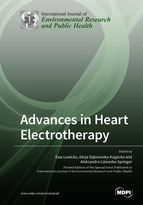Advances in Heart Electrotherapy
A special issue of International Journal of Environmental Research and Public Health (ISSN 1660-4601). This special issue belongs to the section "Global Health".
Deadline for manuscript submissions: closed (31 December 2022) | Viewed by 18422
Special Issue Editors
Interests: cardiac pacing; hemodynamics of cardiac pacing; cardiac resynchronization therapy; heart failure; pulmonary hypertension; atrial fibrillation; ventricular arrhythmias; cardio-oncology
Interests: electrotherapy; cardiac pacing; cardiac resynchronization therapy; heart failure; cardiomyopathies; pulmonary hypertension; atrial fibrillation; echocardiography
Interests: ventricular and atrial arrhythmias; sudden cardiac death; heart failure; cardiac electrotherapy; cardiac pacing; echocardiography; ultrasound imaging
Special Issue Information
Dear Colleagues,
The introduction of permanent cardiac pacing in the late 1950s began the era of cardiac electrotherapy. In the 1980s, implantable cardioverter defibrillators (ICDs) were introduced. These advances created new challenges for cardiac implantable electronic devices (CIEDs). Right ventricular pacing was the primary breakthrough; however, over the years, it has become apparent that it can induce cardiac contraction dyssynchrony. Biventricular pacing allowed for the alleviation of dyssynchrony and improved the survival of patients with heart failure and bundle branch block. In recent decades, His bundle pacing has become a new strategy for physiological ventricular activation. However, the use of CIEDs carries several risks and is associated with complications related to, for example, transvenous leads. This led to the development of percutaneous lead extraction techniques as well as the introduction of a subcutaneous ICD (S-ICD) and leadless pacing. Technological evolution promises an exciting future in the development of cardiac electrotherapy.
In this Special Issue, we invite researchers to submit high quality original or review papers on the clinical and hemodynamic aspects of atrial, right ventricular, His bundle, and biventricular pacing; ICD therapy; treatment of complications, and technological advances in cardiac electrotherapy.
Prof. Dr. Ewa Lewicka
Prof. Dr. Alicja Dąbrowska-Kugacka
Dr. Aleksandra Liżewska-Springer
Guest Editors
Manuscript Submission Information
Manuscripts should be submitted online at www.mdpi.com by registering and logging in to this website. Once you are registered, click here to go to the submission form. Manuscripts can be submitted until the deadline. All submissions that pass pre-check are peer-reviewed. Accepted papers will be published continuously in the journal (as soon as accepted) and will be listed together on the special issue website. Research articles, review articles as well as short communications are invited. For planned papers, a title and short abstract (about 100 words) can be sent to the Editorial Office for announcement on this website.
Submitted manuscripts should not have been published previously, nor be under consideration for publication elsewhere (except conference proceedings papers). All manuscripts are thoroughly refereed through a single-blind peer-review process. A guide for authors and other relevant information for submission of manuscripts is available on the Instructions for Authors page. International Journal of Environmental Research and Public Health is an international peer-reviewed open access monthly journal published by MDPI.
Please visit the Instructions for Authors page before submitting a manuscript. The Article Processing Charge (APC) for publication in this open access journal is 2500 CHF (Swiss Francs). Submitted papers should be well formatted and use good English. Authors may use MDPI's English editing service prior to publication or during author revisions.
Keywords
- Cardiac pacing
- Cardiac resynchronization therapy
- Biventricular pacing
- His bundle pacing
- Implantable cardioverter-defibrillator
- Subcutaneous cardioverter-defibrillator
- Leadless pacing
- Transvenous
- Lead
- Extraction
- Management
- Cardiac
- Implantable
- Electronic
- Device
- Infection
- Indications
- Complications








